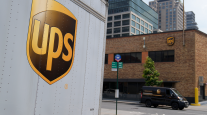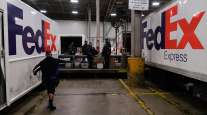Return to Sender: Gift Returns Swamping Shippers
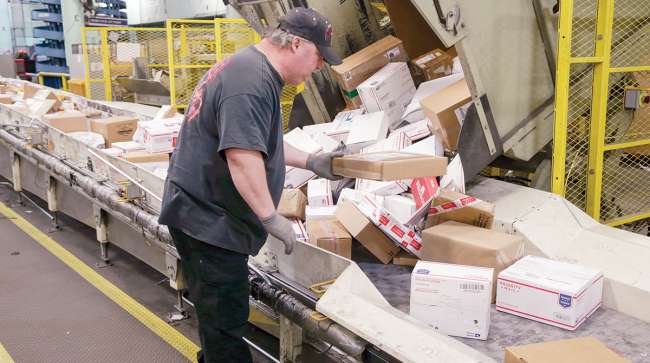
[Stay on top of transportation news: Get TTNews in your inbox.]
Last week, customers at the UPS Store in Seattle’s Interbay neighborhood got a pretty good demonstration of what the global supply chain looks like when you try to run it backward.
The first Monday of the year marks the traditional start of the holiday return season, which this year is expected to break records for returned purchases — and by late afternoon, the line of box-bearing UPS customers snaked nearly out the door.
“Oh my goodness — wow,” said Erin Metzger, half a dozen returns in hand, as she surveyed the crowd and the Jenga-like towers of outbound packages behind the counter. “I did not expect this at all.”
“It comes in waves,” employee Rebecca Yazzie said. “It’ll be quiet for a little bit and then we’ll get a ton of people all at once.”
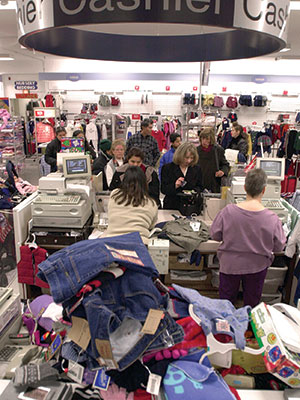
Returned holiday gifts are piled on a counter at a Sears Store in Chicago, Ill. (Tannen Maury/Bloomberg)
Those waves were also being felt across town at Sip and Ship, a coffee-shop-and-mailbox-services combo in Greenwood, Wash., where holiday returns are already 20%-25% ahead of last year. That’s just “so far,” cautioned owner Diana Naramore as she stood next to an 8-foot stack of U.S. Postal Service returns. “I mean, we’re just starting.”
While January has always been send-it-back season, COVID-19 has supersized the trend. Of the record $222 billion Americans spent on online holiday purchases this season, 30%, or nearly $67 billion, will be sent back, according to CBRE, a commercial real estate firm that also focuses on retail logistics. That’s a 13% increase versus 2020 and 40% versus 2019.
That extra load is causing friction for shippers, many of which were already struggling with staffing shortages amid the pandemic.
It’s also pressuring retailers, especially smaller brick-and-mortar shops that went online to survive COVID but often can’t afford the generous return policies popularized by mega-players such as Amazon and Walmart.
“If we paid all the shipping costs and then we have to pay to have that item returned and then we have to pay additionally to send a new item ... it’s not sustainable,” says Brittney Geleynse of Clover Toys, which, like many smaller retailers, has had to scrutinize its return policy as its internet sales have bloomed.
In some ways, this year’s return surge is a story about the ill-timed arrival of omicron, which pushed many holiday shoppers away from brick-and-mortar retail and toward e-commerce, experts say.
But it’s also a story about the way consumers now use e-commerce to hedge their bets.
Many holiday shoppers, fearful of supply chain shortages, intentionally overbought rather than risk not having gifts in time, according to an Oracle Retail survey. That has all but locked in higher returns this season. “Everyone that bought online this year expects to return at least three things,” said Chris McDonald, UPS’ Seattle-area business development manager, citing industry data.
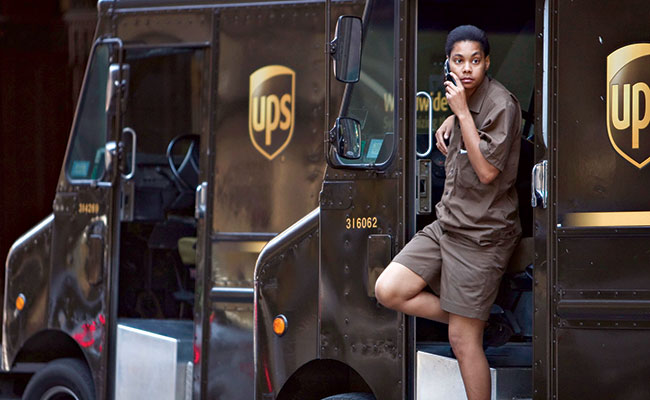
A UPS driver talks on a cell phone as she looks out from her truck in New York. (Jeremy Bales/Bloomberg)
But even before the holidays, consumers were sending back e-commerce purchases two to three times as often as in-person purchases, industry data shows. That’s partly because online purchases are more likely to not fit or otherwise satisfy shoppers.
But it’s also because some retailers have made online returns so painless that consumers see overbuying as a perfectly acceptable way of sampling products.
On top of free or nearly free shipping, many bigger retailers have contracts with UPS and FedEx and others to repackage customers’ returns.
Roger Low, who owns the Interbay UPS Store, says many customers arrive with returns in plastic bags or nothing; last week someone dropped off a shirt, which a staffer dutifully folded, packaged and placed in a bin.
Incentives like these have led to certain excesses. After last summer’s heat wave, Seattle-area shoppers returned “close to 30” air conditioners to the Interbay store alone, Low says. Shoppers have also tried to send back fully assembled e-bikes, sales of which soared in the pandemic. “The driver will show up and there’s just, like, ‘Here’s a bike, you need to take this bike,’ ” UPS’ McDonald said.
But mainly, easy returns have encouraged what retail analysts call “bracketing” — that is, buying multiples of an item in different sizes or styles and returning what doesn’t work.
Bracketing was a thing well before COVID, but it seems to have jumped during the pandemic, as shoppers avoid the risk of in-person shopping. Low routinely sees customers sending back multiples of the same bathing suits, for example, or “six pairs of baby shoes in different colors or sizes.”

In this special 2021 Roundabout episode, host Mike Freeze looks back at how trucking not only worked to recover from the effects of the pandemic, but also improve through the darkest of times. Hear a snippet above, and get the full program by going to RoadSigns.TTNews.com.
Whether supercharged returns outlast the pandemic isn’t clear. If shoppers love the convenience, those convenience providers have mixed feelings.
Drop-off locations earn a small handling fee from shippers — Sip and Ship, for example, gets 50 cents for each UPS and FedEx return, but nothing for USPS. Yet, while that rarely covers the extra labor or insurance, many are loathe to charge extra for a service many consumers now seem to regard as a constitutional right.
“Most people have gotten used to it, but it’s incredible how many people get very, very mad about the dollar,” Sabrina Rinderle, proprietor of Queen Anne Dispatch, said about a fee the mail services/gift shop started charging for USPS packages.
The biggest pushback, paradoxically, may come from retailers. This year, they’ll lose $33 per returned item, up 59% from last year, according to an estimate by Optoro, an expert in so-called reverse logistics.
That’s partly because many returns are marked down and sold on secondary markets; but it also reflects the inefficiencies of trying to push products back up the supply chain: E-commerce returns typically take more labor and space than do the original e-commerce shipments, according to CBRE.
“The supply chain, in general, wasn’t built to go backwards,” says John Morris, who runs CBRE’s logistics service line.
That’s one reason some retailers simply write off lower-value returns. “This year, for the first time ... I called for the return label and they said, ‘Keep it,’ “ said Amy Doerzbacher, who was dropping off a return at Sip and Ship.
Per a survey from the RLA, over 1/2 respondents expect product return costs to rise, and 65% expect the volume of returns to increase... https://t.co/HsiXxYFXgs #reverselogistics #returns #returnsmanagement #ecommerce #retail pic.twitter.com/pPvZtGpKDT — Reverse Logistics Association (@RL_Association) January 8, 2022
Other returns are simply thrown out: roughly 2.9 million tons of returns went into landfills in 2020, according to Optoro, and that number is expected to grow this year, adds CRBE’s Morris.
Some industry experts think retailers will have little choice but to try to tamp down the send-it-back business model — for example, by encouraging customers to bring e-commerce returns to retailers’ brick-and-mortar locations. Some UPS Store officials say some big retailers are already selectively raising return fees for “serial returners.”
Some smaller retailers, meanwhile, are taking a more proactive approach — by trying to sell things customers won’t want to send back in the first place, but also by carefully setting expectations about returns.
If a product doesn’t fit, “we’ll work with you,” said Devynn Patterson at Marakesh Leather, a Seattle company whose online sales jumped from 5% to around 35% of its total during the pandemic. “But we’re not in a position where we can just allow people to wear merch and decide they don’t like it and return it.”
“We do as much as we can to stay competitive,” Patterson added. But “we try to make it clear that, ‘Hey, we’re a small family business.’ ”
Want more news? Listen to today's daily briefing below or go here for more info:
Distributed by Tribune Content Agency, LLC



